

Compact Muon Solenoid
LHC, CERN
| CMS-EXO-12-048 ; CERN-PH-EP-2014-164 | ||
| Search for dark matter, extra dimensions, and unparticles in monojet events in proton-proton collisions at $\sqrt{s}$ = 8 TeV | ||
| CMS Collaboration | ||
| 15 August 2014 | ||
| Eur. Phys. J. C 75 (2015) 235 | ||
| Abstract: Results are presented from a search for particle dark matter (DM), extra dimensions, and unparticles using events containing a jet and an imbalance in transverse momentum. The data were collected by the CMS detector in proton-proton collisions at the LHC and correspond to an integrated luminosity of 19.7 fb$^{-1}$ at a centre-of-mass energy of 8 TeV. The number of observed events is found to be consistent with the standard model prediction. Limits are placed on the DM-nucleon scattering cross section as a function of the DM particle mass for spin-dependent and spin-independent interactions. Limits are also placed on the scale parameter $M_\mathrm{D}$ in the ADD model of large extra dimensions, and on the unparticle model parameter $\Lambda_\mathrm{U}$. The constraints on ADD models and unparticles are the most stringent limits in this channel and those on the DM-nucleon scattering cross section are an improvement over previous collider results. | ||
| Links: e-print arXiv:1408.3583 [hep-ex] (PDF) ; CDS record ; inSPIRE record ; Public twiki page ; CADI line (restricted) ; | ||
| Figures | |
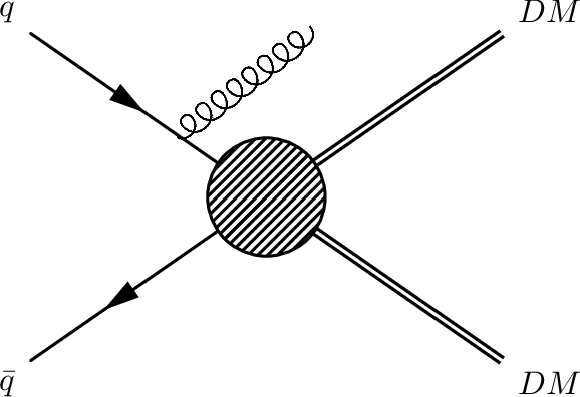
png pdf |
Figure 1-a:
Feynman diagrams for the pair production of DM particles for the case of a contact interaction (a) and the exchange of a mediator (b). |
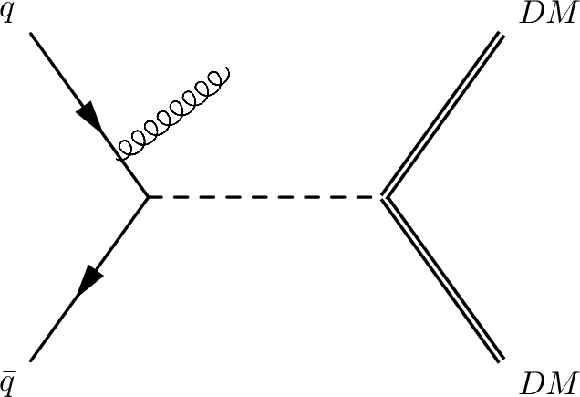
png pdf |
Figure 1-b:
Feynman diagrams for the pair production of DM particles for the case of a contact interaction (a) and the exchange of a mediator (b). |

png pdf |
Figure 2-a:
Feynman diagrams for the production of a graviton (G) or unparticles (U) in association with a jet. |
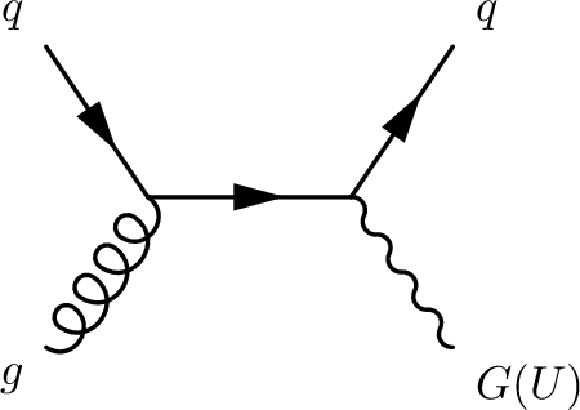
png pdf |
Figure 2-b:
Feynman diagrams for the production of a graviton (G) or unparticles (U) in association with a jet. |
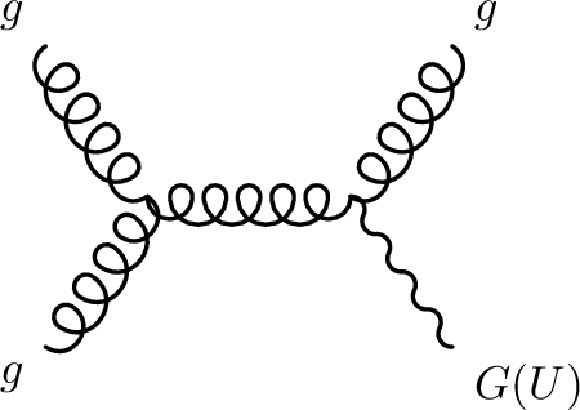
png pdf |
Figure 2-c:
Feynman diagrams for the production of a graviton (G) or unparticles (U) in association with a jet. |

png pdf |
Figure 3:
Missing transverse energy $ {E_{\mathrm {T}}^{\text {miss}}} $ after all selections for data and SM backgrounds. The processes contributing to the SM background are from simulation, normalised to the estimation from data using the ${E_{\mathrm {T}}^{\text {miss}}} $ threshold of 500 GeV. The error bars in the lower panel represent the statistical uncertainty. Overflow events are included in the last bin. |
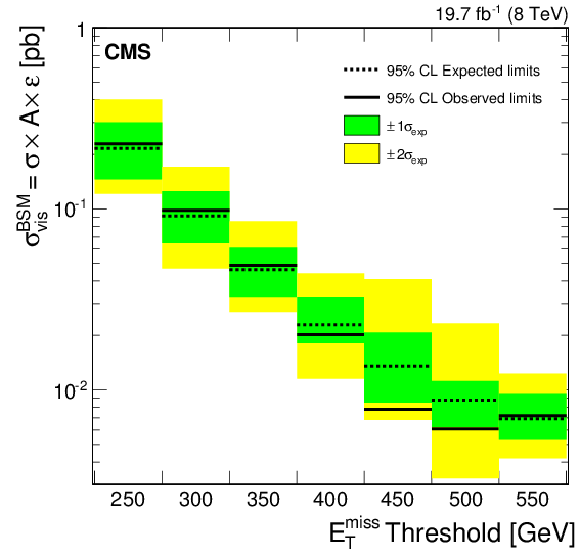
png pdf |
Figure 4:
The model-independent observed and expected 95% CL upper limits on the visible cross section times acceptance times efficiency ($\sigma \times A \times \varepsilon $) for non-SM production of events. Shaded areas show the $\pm 1\sigma $ and $\pm 2\sigma $ bands on the expected limits. |
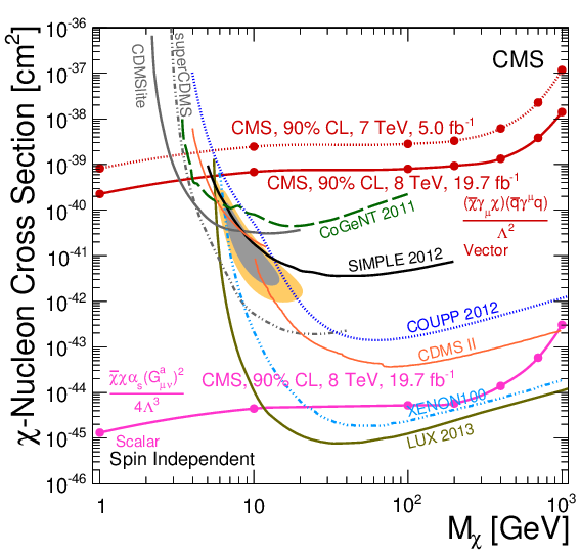
png pdf |
Figure 5-a:
Upper limits on the DM-nucleon cross section, at 90% CL, plotted against DM particle mass and compared with previously published results. (a): limits for the vector and scalar operators from the previous CMS analysis, together with results from the CoGeNT, SIMPLE, COUPP, CDMS, SuperCDMS, XENON100, and LUX collaborations. The solid and hatched yellow contours show the 68% and 90% CL contours respectively for a possible signal from CDMS. (b): limits for the axial-vector operator from the previous CMS analysis, together with results from the SIMPLE, COUPP, Super-K, and IceCube collaborations. |
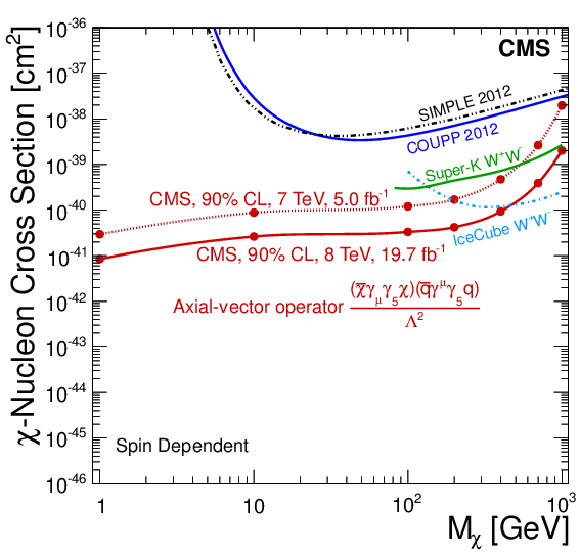
png pdf |
Figure 5-b:
Upper limits on the DM-nucleon cross section, at 90% CL, plotted against DM particle mass and compared with previously published results. (a): limits for the vector and scalar operators from the previous CMS analysis, together with results from the CoGeNT, SIMPLE, COUPP, CDMS, SuperCDMS, XENON100, and LUX collaborations. The solid and hatched yellow contours show the 68% and 90% CL contours respectively for a possible signal from CDMS. (b): limits for the axial-vector operator from the previous CMS analysis, together with results from the SIMPLE, COUPP, Super-K, and IceCube collaborations. |
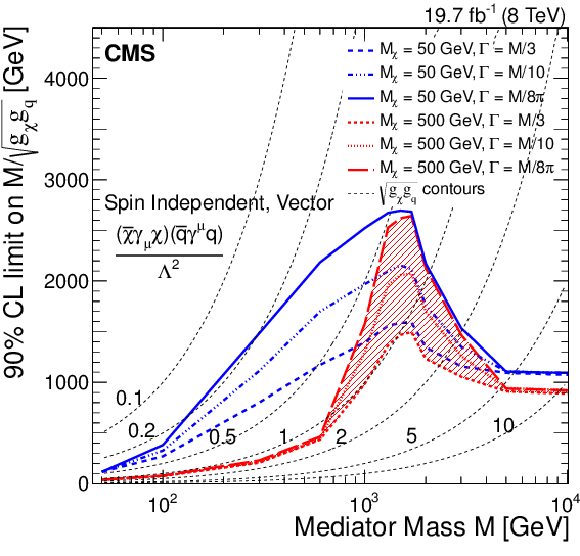
png pdf |
Figure 6:
Observed limits on the mediator mass divided by coupling, $M/\tmspace -\thinmuskip {.1667em}\sqrt {g_{\chi }g_{ {\mathrm {q}}}}$, as a function of the mass of the mediator, $M$, assuming vector interactions and a dark matter mass of 50 GeV (blue, filled) and 500 GeV (red, hatched). The width, $\Gamma $, of the mediator is varied between $M/3$ and $M/8\pi $. The dashed lines show contours of constant coupling $\sqrt {g_{\chi }g_{ {\mathrm {q}}}}$. |
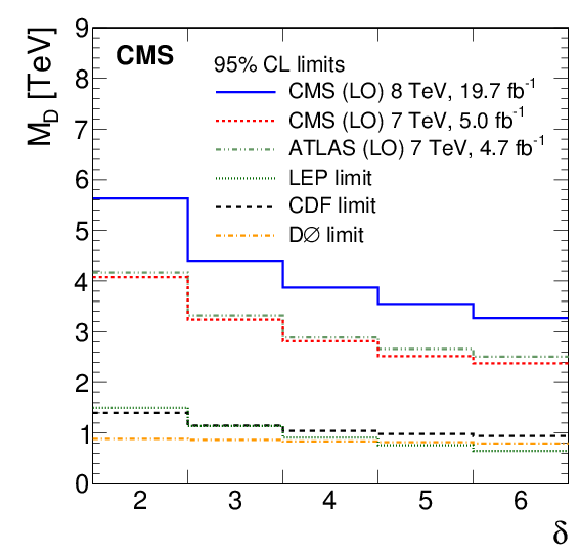
png pdf |
Figure 7:
Lower limits at 95% CL on $ {{M_\mathrm {D}}} $ plotted against the number of extra dimensions $\delta $, with results from the ATLAS, CMS, LEP, CDF, and D$\O$. |

png pdf |
Figure 8:
The expected and observed lower limits on the unparticle model parameters $ {{\Lambda _\mathrm {U}}} $ as a function of $d_\mathrm {U}$ at 95% CL, compared to previous results. The shaded region indicates the side of the curve that is excluded. |
| Tables | |

png pdf |
Table 1:
Summary of the statistical and systematic contributions to the total uncertainty on the Z($\nu\nu$) background. |

png pdf |
Table 2:
Summary of the statistical and systematic contributions to the total uncertainty on the W+jets background from the various factors used in the estimation from data. |
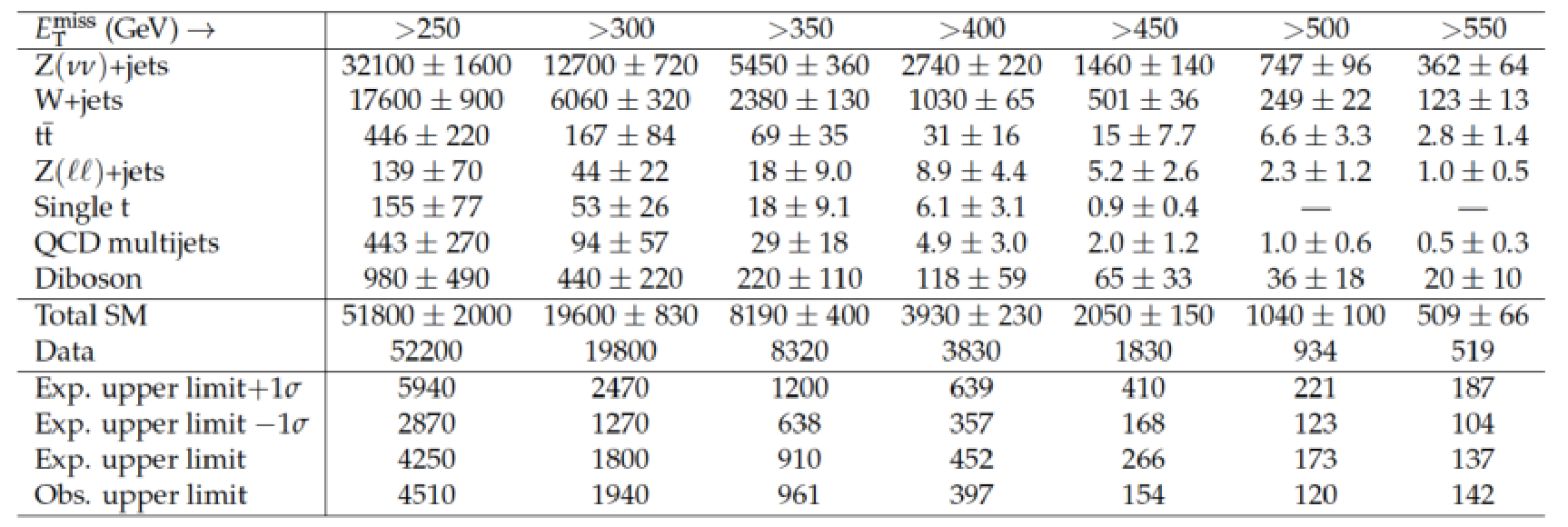
png pdf |
Table 3:
SM background predictions for the numbers of events passing the selection requirements, for various $E_{\mathrm{T}}^{\text{miss}}$ thresholds, compared with the observed numbers of events. The uncertainties include both statistical and systematic components. The last two rows give the expected and observed upper limits, at 95% CL, for the contribution of events from non-SM sources passing the selection requirements. |

png pdf |
Table 4:
Expected and observed 90% CL upper limits on the DM-nucleon cross section, $\sigma_{\chi N}$, and 90% CL lower limits on the effective contact interaction scale, $\Lambda$, for the vector operator. |

png pdf |
Table 5:
Expected and observed 90% CL upper limits on the DM-nucleon cross section, $\sigma_{\chi N}$, and 90% CL lower limits on the effective contact interaction scale, $\Lambda$, for the axial-vector operator. |

png pdf |
Table 6:
Expected and observed 90% CL upper limits on the DM-nucleon cross section, $\sigma_{\chi N}$, and 90% CL lower limits on the effective contact interaction scale, $\Lambda$, for the scalar operator. |
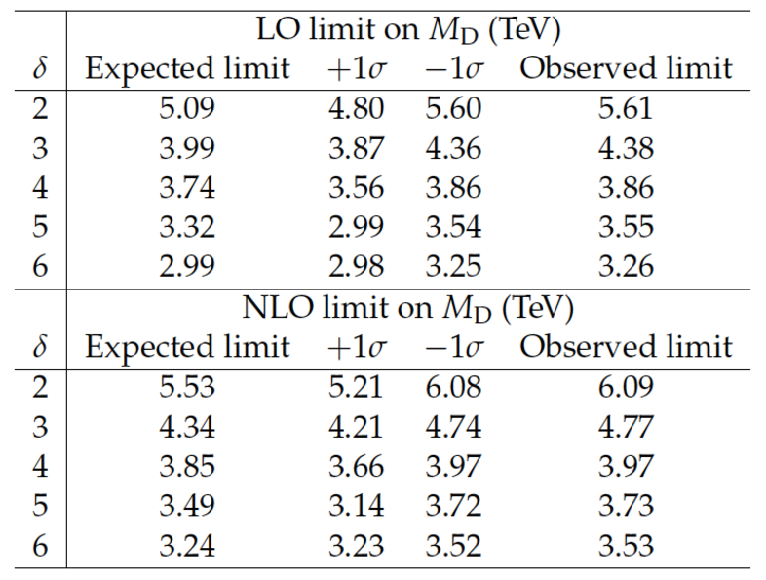
png pdf |
Table 7:
Expected and observed 95% CL lower limits on ADD model parameter $M_D$ in TeV as a function of $\delta$ at LO and NLO. |

png pdf |
Table 8:
Expected and observed 95% CL lower limits on $\Lambda_U$ (in TeV) for scalar unparticles with $d_U =$1.5, 1.6, 1.7, 1.8 and 1.9 and a fixed coupling constant $\lambda =$ 1. |
| Summary |
| A search for particle dark matter, large extra dimensions, and unparticle production has been performed in the monojet channel using a data sample of proton-proton collisions at $\sqrt{s} =$ 8 TeV corresponding to an integrated luminosity of 19.7 fb$^{-1}$. The dominant backgrounds to this topology are from Z($\nu\nu$)+jets and W($\ell\nu$)+jets events, and are estimated from data samples of Z($\mu\mu$) and W($\mu\nu$) events, respectively. The data are found to be in agreement with expected contributions from standard model processes. Limits are set on the DM-nucleon scattering cross section assuming vector, axial-vector, and scalar operators. Limits are also set on the fundamental Planck scale MD in the ADD model of large extra dimensions and on the unparticle model parameter $\Lambda_U$. Compared to previous CMS publications in this channel, the lower limits on MD represent an approximately 40% improvement, and the lower limits on the unparticle model parameter $\Lambda_U$ represent an improvement by a factor of roughly 3. The upper limit on the DM-nucleon cross section has been reduced from 8.79 $\times$ 10$^{-41}$ cm$^2$ to 2.70 $\times$ 10$^{-41}$ cm$^2$ for the axial-vector operator and from 2.47 $\times$ 10$^{-39}$ cm$^2$ to 7.06 $\times$ 10$^{-40}$ cm$^2$ for the vector operator for a particle DM mass of 10 GeV. The constraints on ADD models and unparticles are the most stringent limits in this channel and those on the DM-nucleon scattering cross section are an improvement over previous collider results. |

|
Compact Muon Solenoid LHC, CERN |

|

|

|

|

|

|